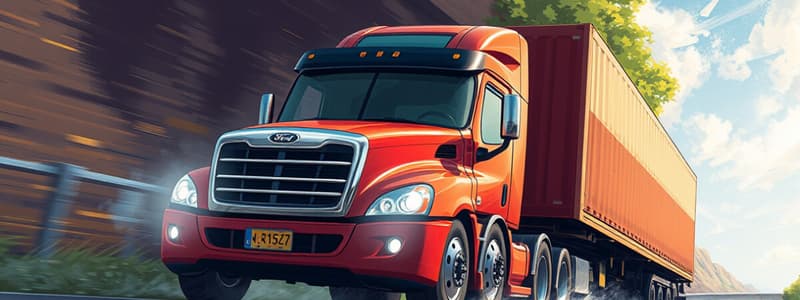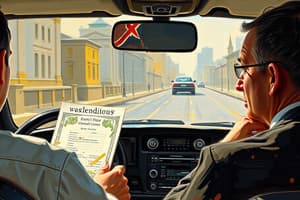Podcast
Questions and Answers
What is Class A defined as?
What is Class A defined as?
- Any combination of motor vehicles with a GCWR of 26,001 pounds or more (correct)
- Any single motor vehicle with a GCWR of 26,001 pounds or more
- Any motor vehicle with a GVWR of 16,000 pounds or less
- Any motor-driven cycle with less than 150cc displacement
What is the definition of Class B?
What is the definition of Class B?
Any single motor vehicle with a GCWR of 26,001 pounds or more or any such vehicle towing another not in excess of 10,000 pounds.
Define Class C.
Define Class C.
Any motor vehicle with a GVWR of more than 16,000 pounds, but less than 26,001 pounds or any such vehicle towing another not in excess of 10,000 pounds.
What does Class D refer to?
What does Class D refer to?
What is the requirement for Class I designated highways?
What is the requirement for Class I designated highways?
What is the maximum allowable wheelbase for Class II designated highways?
What is the maximum allowable wheelbase for Class II designated highways?
What is the maximum height for all vehicles on highways?
What is the maximum height for all vehicles on highways?
What does the term 'Combination of vehicles specially designed to transport motor vehicles' refer to?
What does the term 'Combination of vehicles specially designed to transport motor vehicles' refer to?
What is the meaning of 'Farm Width Exemption'?
What is the meaning of 'Farm Width Exemption'?
The maximum width for most vehicles is ______ feet.
The maximum width for most vehicles is ______ feet.
When must safety lights or flares be placed on vehicles carrying explosives?
When must safety lights or flares be placed on vehicles carrying explosives?
Buses operating within city limits can have a maximum width of 9 feet.
Buses operating within city limits can have a maximum width of 9 feet.
What is indicated by the term 'Towed Vehicles'?
What is indicated by the term 'Towed Vehicles'?
What action should be taken in the event of a tire failure?
What action should be taken in the event of a tire failure?
Flashcards
Class A Vehicle
Class A Vehicle
A vehicle with a combined gross vehicle weight rating (GVWR) exceeding 26,001 pounds and a towed vehicle weighing over 10,000 pounds.
Class B Vehicle
Class B Vehicle
A single vehicle with a GVWR exceeding 26,001 pounds, capable of towing another vehicle up to 10,000 pounds.
Class C Vehicle
Class C Vehicle
A vehicle with a GVWR ranging from 16,001 to 26,000 pounds, or towing a vehicle not exceeding 10,000 pounds.
Class D Vehicle
Class D Vehicle
A vehicle with a GVWR of 16,000 pounds or less, excluding other categories like motorcycles.
Signup and view all the flashcards
Class I Highway
Class I Highway
A highway with no restrictions on overall vehicle length.
Signup and view all the flashcards
Class II Highway
Class II Highway
A highway with no overall length limit, but with specific limits on wheelbase for certain vehicle combinations.
Signup and view all the flashcards
Class III Highway
Class III Highway
A highway with specific limits on overall length and wheelbase for certain vehicle combinations.
Signup and view all the flashcards
Non-Designated Street
Non-Designated Street
A highway with a maximum overall length limit of 55 feet for truck tractor-semitrailer combinations and 60 feet for all other vehicles.
Signup and view all the flashcards
Maximum Vehicle Width
Maximum Vehicle Width
The maximum allowed width for most vehicles, with exceptions on some highways.
Signup and view all the flashcards
Maximum Vehicle Height
Maximum Vehicle Height
The maximum allowed height for all vehicles, including the load.
Signup and view all the flashcards
Maximum Single Axle Weight
Maximum Single Axle Weight
The maximum weight allowed on a single axle on designated highways.
Signup and view all the flashcards
Maximum Tandem Axle Weight
Maximum Tandem Axle Weight
The maximum weight allowed on tandem axles on designated highways.
Signup and view all the flashcards
Maximum 5-Axle Combination Weight
Maximum 5-Axle Combination Weight
The maximum weight allowed on a five-axle combination on designated highways.
Signup and view all the flashcards
Disabled Vehicle Lighting Requirements
Disabled Vehicle Lighting Requirements
The specific lighting configurations and reflectors required for disabled vehicles operated outside city limits from sunset to sunrise.
Signup and view all the flashcardsStudy Notes
Classifications of Vehicles
- Class A: Combines vehicles with a GCWR of 26,001+ pounds; towed vehicle must exceed 10,000 pounds.
- Class B: Single vehicle with a GCWR of 26,001+ pounds; can tow another vehicle up to 10,000 pounds.
- Class C: Vehicles with GVWR between 16,001 and 26,000 pounds, or towing another not over 10,000 pounds.
- Class D: Vehicles with a GVWR of 16,000 pounds or less; does not include classes A, B, C, L, or M.
- Class L: Motor-driven cycles with less than 150cc displacement.
- Class M: Motor-driven cycles with more than 150cc displacement.
Highway Classifications
- Class I: No overall length limit for vehicles.
- Class II: No overall length limit; maximum wheelbase is 55 feet for truck tractor-semitrailer combinations, 65 feet for double-bottom combinations.
- Class III: Maximum wheelbase is 55 feet for certain combinations; limit of 60 feet total length including load for others.
- Non-designated Streets: Maximum overall length is 55 feet for truck tractor-semitrailer and 60 feet for all others.
Vehicle Dimensions and Weight Limits
- Width: Maximum width generally is 8 feet; 8 feet, 6 inches allowed on certain highways.
- Height: All vehicles have a maximum height of 13 feet, 6 inches including load.
- Weight (Designated Highways): Limits are 20,000 pounds on a single axle, 34,000 pounds on tandem axles, and up to 80,000 pounds on 5-axle combinations.
- Weight (Non-Designated): Same limits apply, with exceptions for certain vehicles allowed by statutes.
Lighting and Reflectors Requirements
- Lights for Disabled Vehicles: Specific configurations of yellow/amber lights and red reflectors are required when operated outside city limits during sunset to sunrise.
- Trailers: Require two red reflectors and turn signals at specified visibility distances.
- Vehicles with Explosives: Must use specific lighting requirements; no flares allowed for safety.
Safety Protocols for Disabled Vehicles
- Divided Highways: Use safety lights at specified distances to alert oncoming traffic.
- Near Hills and Curves: Warning signals must be placed between 100-500 feet from the disabled vehicle to ensure visibility.
Towing Regulations
- Connection Limits: Must be strong enough to pull the entire weight; drawbar cannot exceed 15 feet.
- Passenger Restrictions: Passengers are generally prohibited in towed vehicles unless specific conditions, like speed and purpose, are met.
Vehicle Operation Safety
- Backing Safely: Emphasizes checking clearance and using a helper for visibility.
- Turning Protocol: Encourage cautious turning and awareness of surrounding traffic to avoid accidents.
- Braking Techniques: Focus on gradual braking processes to maintain control.
Inspections and Tire Management
- Required Instruments: Essential gauges and inspection of cargo covers, mirrors, and tires.
- Tire Failure: Advice includes holding the steering wheel steady and refraining from braking abruptly.
Emergency Procedures
- Fires: Steps include safely pulling off the road and extinguishing fires with proper equipment.
- Skids and Countersteering: In case of rear-wheel skids, the focus is on stopping braking and steering correctly.
CDL Requirements
- Operators Requiring a CDL: Covers specific weight ratings and passenger capacity for various vehicles, including those transporting hazardous materials.
Studying That Suits You
Use AI to generate personalized quizzes and flashcards to suit your learning preferences.




